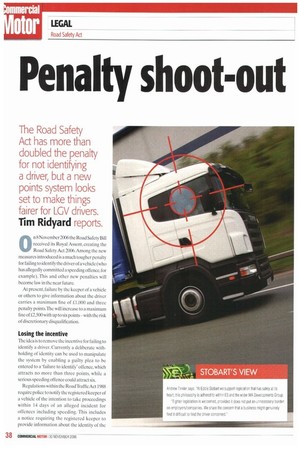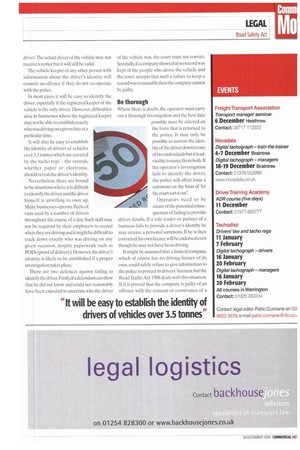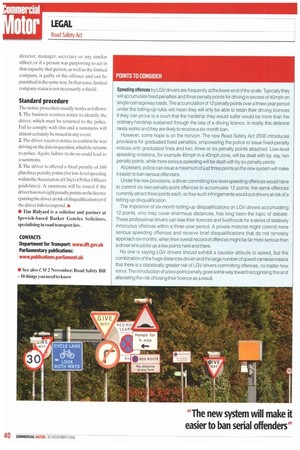Penalty shoot-out
Page 38

Page 39

Page 40

If you've noticed an error in this article please click here to report it so we can fix it.
The Road Safety Act has more than doubled the penalty for not identifying a driver, but a new points system looKs set to make things fairer for LGV drivers.
Tim Ridyard reports.
0 n 8 November 2006 the Road Safety Bill received its Royal Assent, creating the Road Safety Act 2006. Among the new measures introduced is a much tougher penalty for failing to identify the driver of a vehicle (who has allegedly committed a speeding offence, for example). This and other new penalties will become law in the near future.
At present, failure by the keeper of a vehicle or others to give information about the driver carries a maximum fine of i 1 ,000 and three penalty points.The will increase to a maximum fine of 12,500 with up to six points—with the risk of discretionary disqualification.
Losing the incentive
The idea is to remove the incentive for failing to identify a driver. Currently a deliberate withholding of identity can be used to manipulate the system by enabling a guilty plea to be entered to a 'failure to identify' offence, which attracts no more than three points, while a serious speeding offence could attract six.
Regulations within the Road TrafficAct 1988 require police to notify the registered keeper of a vehicle of the intention to take proceedings within 14 days of an alleged incident for offences including speeding. This includes a notice requiring the registered keeper to provide information about the identity of the
driver:The actual driver of the vehicle may not receive a notice but it will still be valid.
The vehicle keeper or any other person with information about the driver's identity will commit an offence if they do not co-operate with the police.
In most cases it will be easy to identify the driver, especially if the registered keeper of the vehicle is the only driver. However, difficulties arise in businesses where the registered keeper may not be able to establish exactly who was driving on a given date at a particular time.
It will also be easy to establish the identity of drivers of vehicles over 3.5 tonnes which are covered by the tacho regs — the records, whether paper or electronic, should reveal the driver's identity.
Nevertheless, there are bound to be situations where it is difficult to identify the driver and the driver himself is unwilling to own up. Many businesses operate fleets of vans used by a number of drivers throughout the course of a day. Such staff may not be required by their employers to record when they are driving and it might be difficult to track down exactly who was driving on any given occasion, despite paperwork such as PODs (proof of delivery). However, the driver's identity is likely to be established if a proper investigation takes place.
There are two defences against failing to identify the driver.Firstlyifa defendant can show that he did not know and could not reasonably have been expected to ascertain who the driver of the vehicle was, the court must not convict. Secondly if a company shows that no record was kept of the people who drove the vehicle and the court accepts that such a failure to keep a record was reasonable then the company cannot be guilty.
Be thorough
Where there is doubt, the operator must carry out a thorough investigation and the best data possible must be entered on the form that is returned to the police. It may only be possible to narrow the identity of the driver down to one of two individuals but it is advisable to name them both, the operator's investigation fails to identify the driver, the police will often issue a summons on the basis of let the court sort it out'.
Operators need to be aware of the potential consequences of failing to provide driver details. If a sole trader or partner of a business fails to provide a driver's identity he may receive a personal summons. If he is then convicted. his own licence will be endorsed even though he may not have been driving.
It might be assumed that a limited company, which of course has no driving licence of its own, could safely refuse to give information to the police to protect its drivers' licences, but the Road Traffic Act 1988 deals with this situation. If it is proved that the company is guilty of an offence with the consent or connivance of a
director, manager, secretary or any similar officer, or if a person was purporting to act in that capacity, that person, as well as the limited company, is guilty of the offence and can he punished in the same way. In that sense. lint ited company status is not necessarily a shield.
Standard procedure
he notice procedure usually works as follows: 1. The business receives notice to identify the driver, which must he returned to the police. Fail to comply with this and a summons will almost certainly be issued in any event.
2. The driver receives notice to confirm he was drivingon the date in question. which he returns to police. Again, failure to do so could lead to a summons.
3. The driver is offered a fixed penalty of 1:60 plus three penalty points( for low-level speeding within theAssociation of Chief of Police Officers guidelines). A summons will be issued if the driver has over eight penalty pointson the licence (put t Mg the driver at risk of disqualification ) or if the driver fails to respond. • • Tim Ridyard is a solicitor and partner at Ipswich-based Barker Cotelee Solicitors. specialising in road transport law.
CONTACTS Department for Transport: www.dft.gov.uk Parliamentary publications: www.publications.parliament.uk • See also CM 2 November: Road Safety Bill lit things you need to know POINTS TO CONSIDER Speeding offences by LGV drivers are frequently at the lower end of the scale. Typically they will accumulate fixed penalties and three penalty points for driving in excess of 40mph on single-carriageway roads. The accumulation of 12 penalty points over a three-year period under the totting-up rules will mean they will only be able to retain their driving licences if they can prove to a court that the hardship they would suffer would be more than the ordinary hardship sustained through the loss of a driving licence. In reality this defence rarely works and they are likely to receive a six-month ban.
However, some hope is on the horizon. The new Road Safety Act 2006 introduces provisions for graduated fixed penalties, empowering the police to issue fixed-penalty notices with graduated fines and two, three or six penalty points attached. Low-level speeding violations, for example 45mph in a 40mph zone, will be dealt with by, say, two penalty points, while more serious speeding will be dealt with by six penalty points.
At present, police can issue a maximum of just three points so the new system will make it easier to ban serious offenders.
Under the new provisions, a driver committing low-level speeding offences would have to commit six two-penalty-point offences to accumulate 12 points; the same offences currently attract three points each. so four such infringements would put drivers at risk of a totting-up disqualification.
The imposition of six-month totting-up disqualifications on LGV drivers accumulating 12 points, who may cover enormous distances, has long been the topic of debate. These professional drivers can lose their licences and livelihoods for a series of relatively innocuous offences within a three-year period. A private motorist might commit more serious speeding offences and receive brief disqualifications that do not remotely approach six months, when their overall record of offences might be far more serious than a driver who picks up a few points here and there.
No one is saying LGV drivers should exhibit a cavalier attitude to speed, but the combination of the huge distances driven and the large number of speed cameras means that there is a statistically greater risk of LGV drivers committing offences, no matter how minor. The introduction of a two-point penalty goes some way toward recognising this and alleviating the risk of losing their licence as a result.


















































































































































































